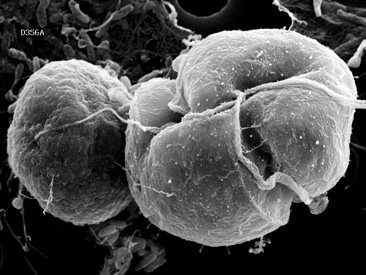Relatively unknown and taxonomically confusing until the last few decades, the tiny but toxic dinoflagellate, Karlodinium veneficum, can produce dense blooms and fish-killing toxins. K. veneficum is a small chlorophyll-containing dinoflagellate thatproduces a suite of potent toxic compounds known as karlotoxins whichkill fish as well as other organisms. K. veneficum has a mixed nutritional mode (mixotrophy) relying on both photosynthesis and phagotrophy (engulfing/ingesting whole prey) for growth. Karlotoxin production appears to be used primarily for prey capture but grazing deterrence is an additional advantage. Researchers have identified many karlotoxins and considerable strain variation in the types and amounts of toxins produced.

NCCOS-sponsored research by Drs. Alan Place (University of Maryland) and Matthew Parrow (University of North Carolina) have described K. veneficum biology and ecology, genetics, and toxicity, recently identifying two new karlotoxins. Dr. Parrow leads a new NCCOS ECOHAB project that is investigating how K. veneficum toxicity varies widely among different bloom populations and within populations over time. The project hypothesis is that slow or non-dividing populations will undergo more karlotoxin synthesis, becoming significantly more toxic.
This project will provide coastal managers knowledge and tools to better predict how, when, and why K. veneficum cells (and thus blooms) become highly toxic. With a single sample managers might be able to determine if the K. veneficum bloom is growing or not, with the lack of growth serving as a possible indicator forhigh bloom toxicity soon after the sample was collected.
For more information, contact John Wickham.
